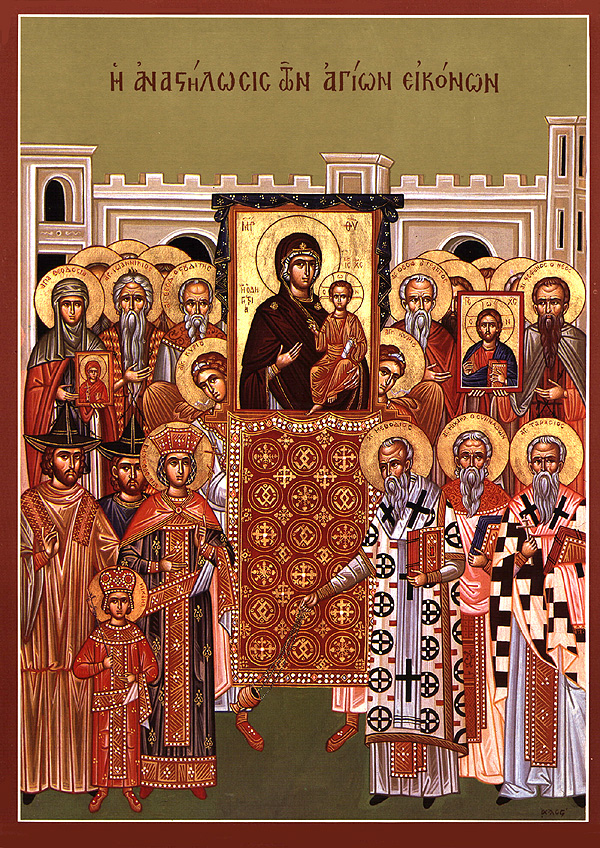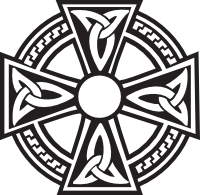Frs. of the 7th Ecumenical Council; Beauty

3rd Sun. of Luke Oct 10, 2021; John 17:1-13: Luke: 7: 11 -16
In today’s Gospel Christ raises the son of the widow of Nain from the dead. Christ is coming into the city gates, she is leaving. This is an intersection we will all cross someday as we leave the gates of this world and look to Christ for mercy and forgiveness in the hope of the resurrection. May we be ever mindful of this scheduled meeting!
Christ is demonstrating His power over death. Christ also raised Jairus’s dead daughter and the 4-day dead Lazarus – who after his 4 days in the grave went on to become the first Bishop of Cyprus. But they soon all died again a second time, but with such a difference… their very death became their entrance into life eternal. Our earthly journey is a fleeting moment, given us seek God, to prepare for and even begin to experience our forever future. At our baptism we die and are born again into new life in Christ and the kingdom of heaven, as surely as we were born into this world through our coming forth from our mother’s womb. (John 11:25,25) “Jesus tells Martha, Lazarus’s sister “I am the resurrection and the life. He who believes in Me, though he may die, he shall live. And whosoever lives and believes in Me, shall never die. Do you believe this?” Death has now become life for us!
We always pray for and with our dearly departed as they have need of our love and prayers, and we have a storehouse of love to give them. We trust that this is a comfort and help to them. It is also a great help for us to be able to direct all the bottled-up love we have for them. We do not know, nor even try to determine exactly how these prayers help, but every service from the very earliest days of the Church has included these supplications for our departed. Our prayers help us to stay connected with our dear ones, and we are especially united with them when we celebrate the timeless eternal Divine Liturgy. Here we are joined with all the Church, those gone before us, and those all around the world joined with us at the Chalice. There are no dead in Christ. Christ says, (Luke 20:38) “He is not the God of the dead but of the living, for all live to Him.” Look around, our walls are adorned with icons of the saints. They are alive and with us. Get to know them, ask for their prayers. Greet them when you come in, they are here with us.
We can thank the 350 Fathers of the 7th Ecumenical council whom we commemorate today for these icons. This “Council of councils” held in Nicaea in 787 is the last Ecumenical Council recognized in the Orthodox Church. These Fathers fought a prolonged battle to restore the icons, and keep us connected with our saintly brothers and sisters from all the ages. Our icons demonstrate with great beauty who Christ is, that we may believe and worship in spirit and truth. The first six ecumenical councils were defining the true nature of Christ, and each council battled heresies which distorted the Orthodox understanding. But the seventh council battled all the heresies which attacked some aspect of Christ’s fullness. Christ must be able to be depicted in an icon, or we deny the fullness of His humanity. And St. Basil in the 4th century stated, “the honour given to the image is transferred to its prototype.” There is no dualistic thinking in the Church where spirit is superior to matter. They are both created and fully blessed by God.
So we can depict Christ, but what about all the icons of the saints? They too are icons of Christ. In the icon of the saint we see Christ shining forth. This is also our purpose in life, to pursue union with Christ with all our heart, mind, and soul. We glorify our saints in as much as we see Christ revealed in them. When we venerate the icon of our patron St. Aidan of Lindisfarne, we are venerating Christ revealed through St. Aidan. We worship God alone, but we venerate and give honour to all those saints through whom God is also revealed to us. The icon of a saint is not a direct representation of Christ, but of the transformation of the saint who working in synergy with Christ, enters into and radiates Christ’s life!
The great Russian theologian Georges Florovsky, gives us even deeper insight into the role of icons in our Churches, “There exists some mysterious objective tie between the “image” and the “Prototype,” between the likeness and the one who is represented, which is specially marked in miracle-working ikons which show God’s power…In the old churches the whole state of the church triumphant would be pictorially represented on the walls. Again this was not just a decoration, nor was it simply a story told in lines and colour for the ignorant and illiterate. It was rather an insight into the invisible reality of the Church. The whole company of Heaven is represented on the walls because it is present there, though invisibly.”
When we enter an Orthodox Church, we are greeted by beautiful iconography. We are material and spiritual creatures, and we relate to God through all our material and spiritual senses. Our eyes take in the beauty of the icons, the candles burning, our hand carved Altar, the colours of the coverings and Clergy vestments. We hear and join in the beautiful singing and chanting, worshiping God, we smell the sweet spiritual fragrance of the incense and see the smoke ascending as prayers to God, we venerate the icons, the cross, reverently touching them with our lips, bowing and crossing ourselves, we taste the bread and wine, transformed into the very body and blood of Christ, and eat of the blessed prosphora bread. All our senses are brought to worship, and our spiritual eyes are opened, and our heart perceives that we are within the kingdom of God.
Dostoevsky famously wrote, “Beauty will save the world.” Beauty always speaks of God, and all of His creation radiates the beauty and order of God. Yet we live in a world filled with suffering, calamities, lies, coercion… none of which have their source in God. How do we keep from despairing when we inevitably encounter suffering and tragedy in our lives? We focus on God, from whom only beauty, truth, and goodness emanate. We thank God for the beauty that permeates all eternal reality. He has transformed death into life, temporary suffering into eternal beauty through the cross! We are drawn to beauty wherever we find it, but especially it should always be found within our Church buildings.
Therefore we hold as precious and most worthy, the work of beautifying our places of worship. Everything in our church should resonate with God’s beauty and order. Our churches are filled with icons not just to demonstrate proper theology, although they certainly do this. But the beautiful icons draw us into the eternal beauty of the kingdom of God, the abode of the saints. On entering a fully frescoed Orthodox Church, we will immediately be struck with the beauty of the kingdom. Our Orthodox buildings should strive to reveal to the world the beauty of God’s kingdom. As the emissaries of Great Prince Vladimir reported when coming back from visiting the glorious church of Hagia Sophia. “We knew not whether we were in heaven or on earth,” such was the beauty.
It is so important that we bring our very best to contribute to establishing God’s beauty in His Church buildings. The beauty and order of the church building itself, representing in its tri-part arrangement – the world, the church, and God’s kingdom. The cupolas, the welcoming entrance, and beauty of the architecture. The icons, the iconostasis, the Altar table, the lighting, and interior finishes. The beauty of the singing, the chanting, the heart felt responses, all of these serve to draw us, and all who are searching for God’s beauty, into the embrace of Christ and His Church. This too is what the Fathers of the 7th Ecumenical Council fought for, and many even gave their lives for. For proper theology and beauty are always united in expressing the fullness of the Orthodox faith. Let us properly celebrate this day of Thanksgiving by giving thanks to God for the beauty of His entire Creation
Glory to God for all things!
